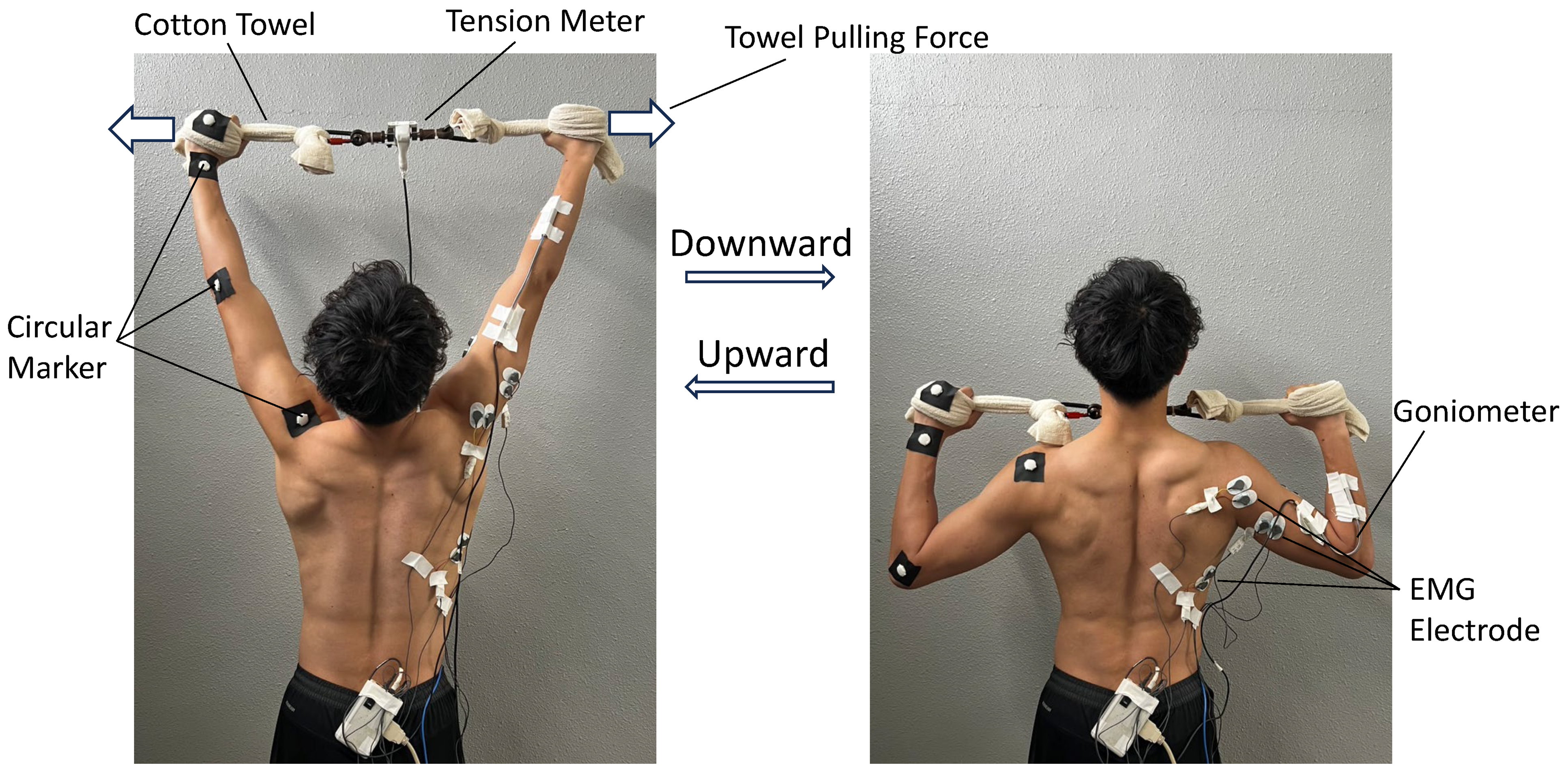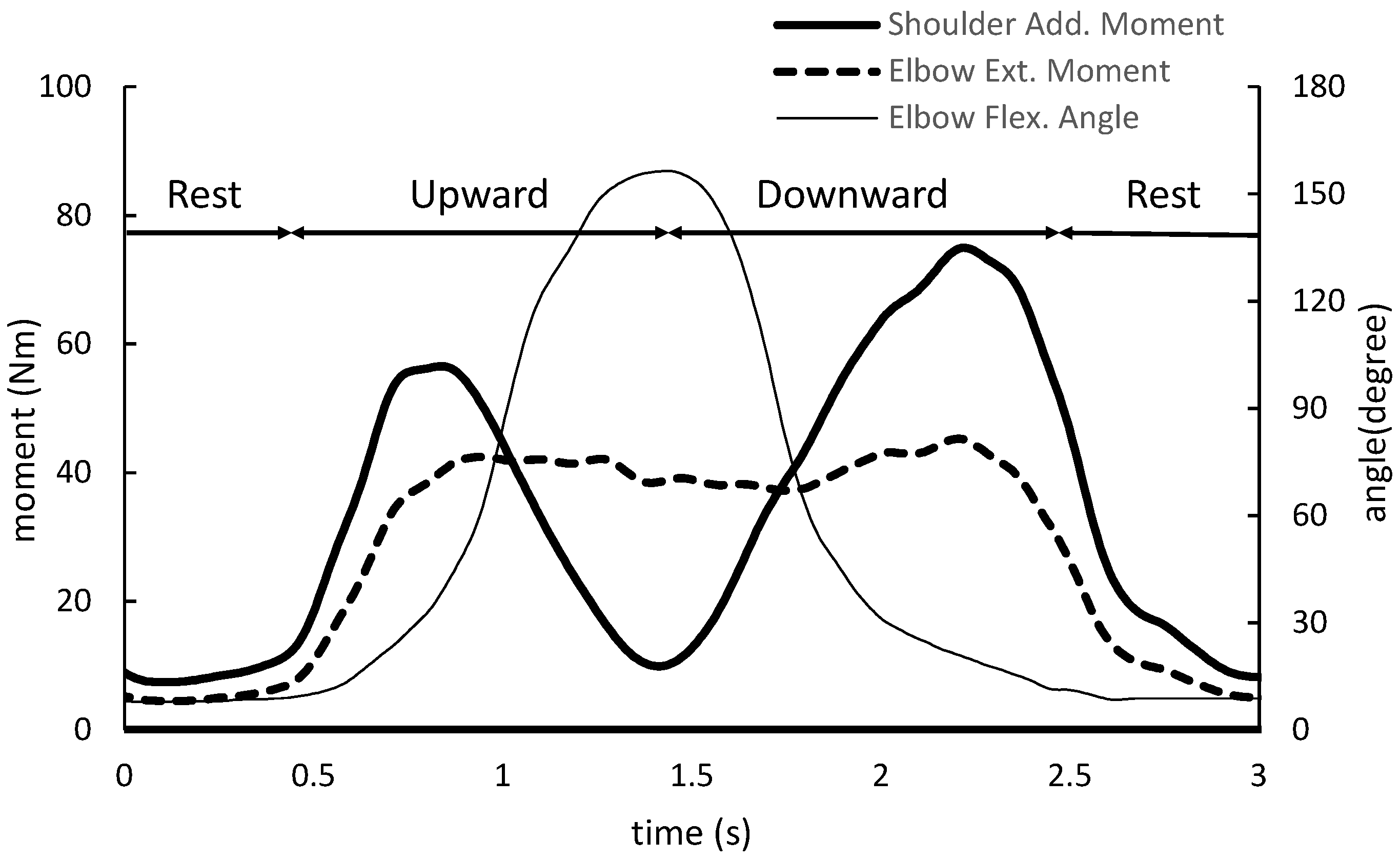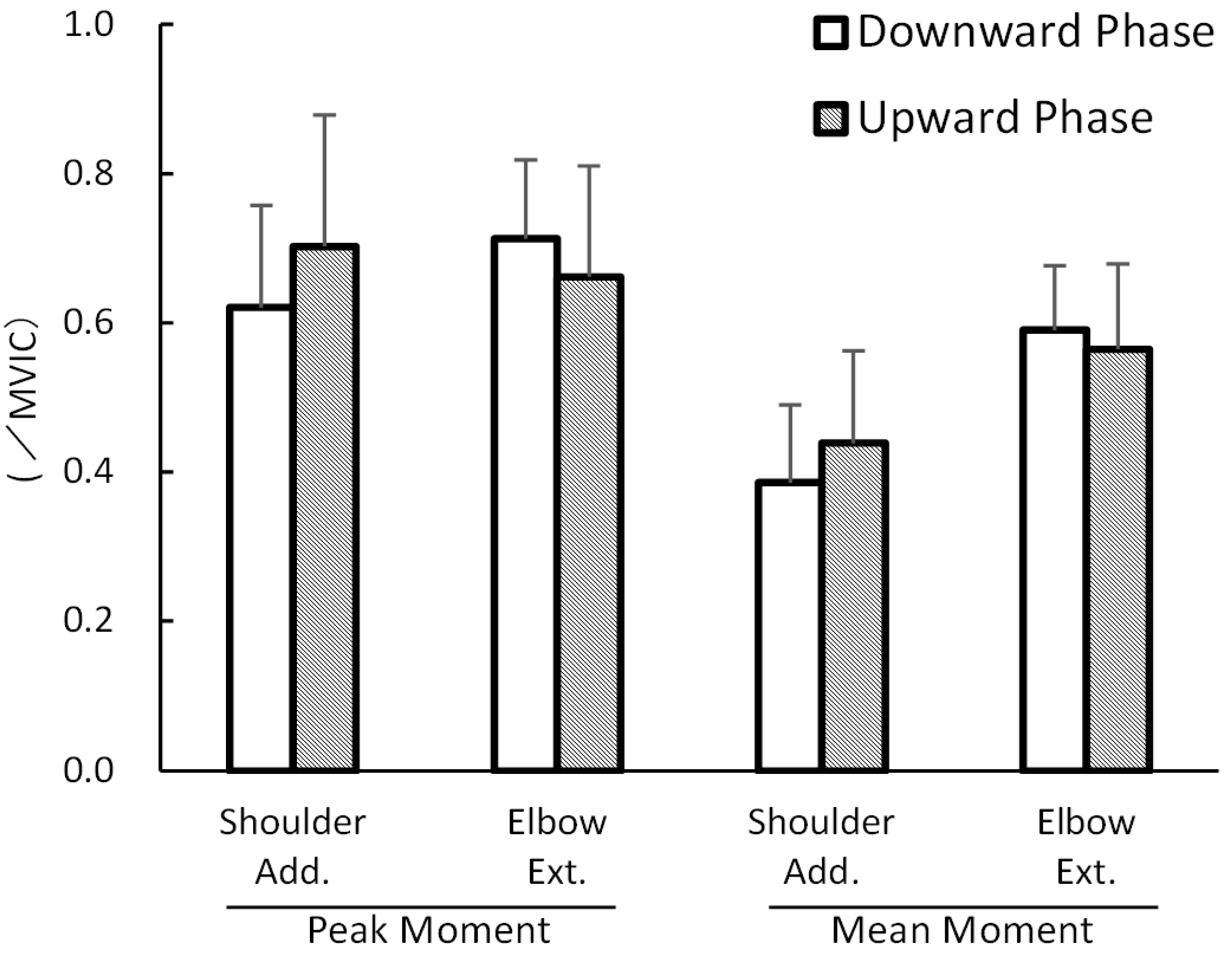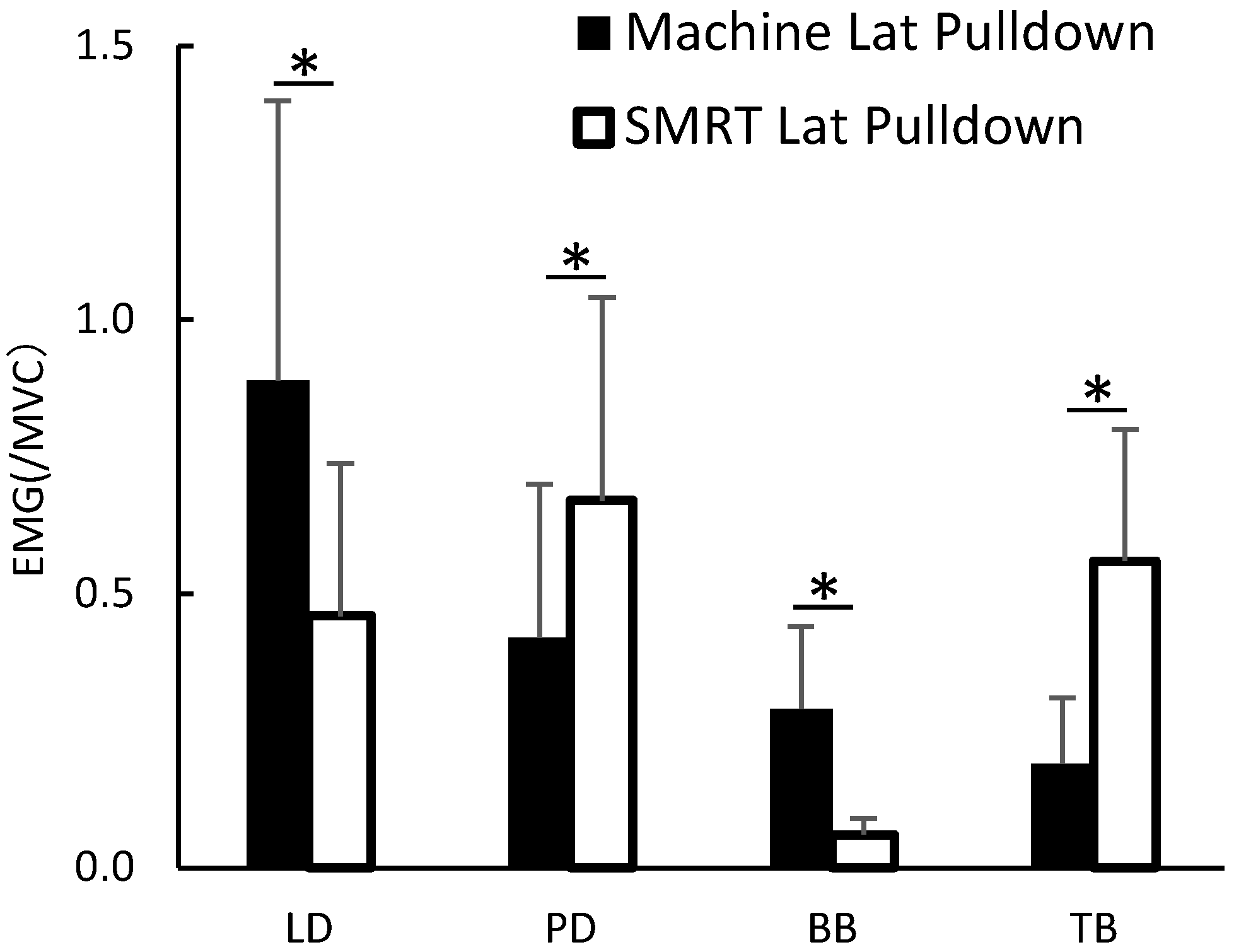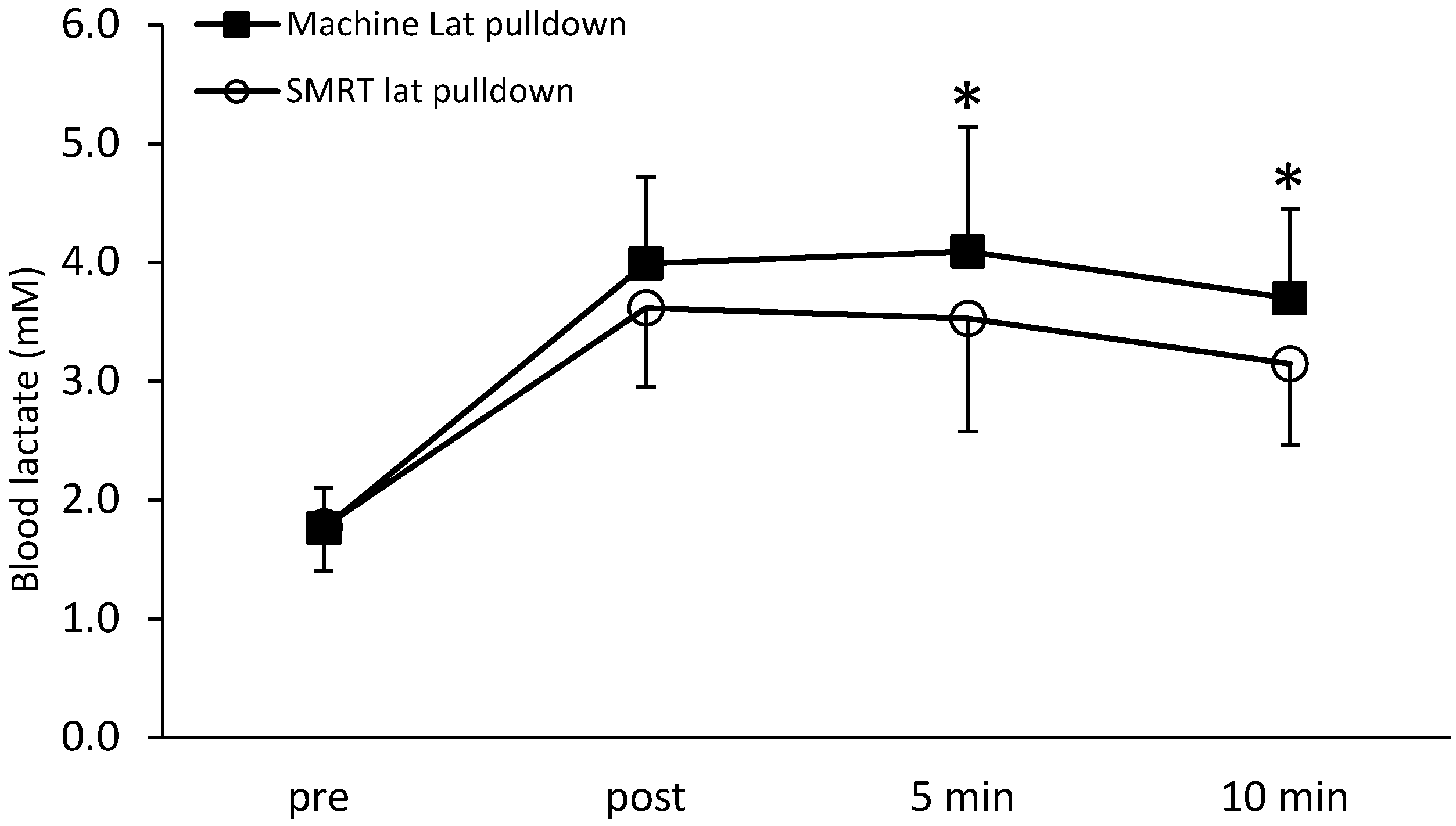1. Introduction
Resistance training (RT), which involves applying external resistance to muscles, is a highly effective method for promoting muscle hypertrophy, increasing muscular strength, and improving overall health [
1]. RT encompasses not only equipment-based methods using barbells, dumbbells, and machines but also equipment-free approaches, such as bodyweight training [
2,
3]. Equipment-free RT may be a useful option for promoting wider public participation due to its accessibility and ease of implementation.
However, equipment-free RT has certain limitations. For example, it is difficult to apply it to pulling movements of the upper limbs, and there is a lack of concrete methods to do so.
Resistance training (RT) using body weight, such as push-ups and squats, can be performed easily without any equipment, making it a practical modality for widespread implementation in school education and community-based health promotion programs. Even with bodyweight RT, progressive loading can be achieved by modifying exercise form, allowing for substantial muscle hypertrophy and strength gains. In exercise intervention studies involving young women without prior training habits, progressive bodyweight training has demonstrated comparable effects on muscle strength and muscular hypertrophy to those of barbell back squat training [
4]. Bodyweight RT relies on gravitational resistance, which makes it inherently difficult to apply sufficient load to pulling movements. Pulling exercises using bodyweight, such as chin-ups and inverted rows, are effective for strengthening the pulling muscle groups [
5,
6], but they require a hanging bar for execution. For example, pushing exercises, such as push-ups, can be performed anywhere without equipment. In contrast, pulling exercises, like chin-ups and inverted rows, require a hanging bar, making them impossible to perform without equipment and therefore difficult to carry out at home.
In addition to bodyweight RT, manual resistance training (MRT) is another equipment-free method of resistance training. MRT has been defined as a form of strength training in which the practitioner performs exercises against a partner’s opposing resistance [
7]. A practitioner’s maximum effort can be maintained throughout the entire range of motion in each repetition. The resistance is adjusted by the partner in response to the practitioner’s strength capacity, allowing for consistent maximal effort across repetitions. A 14-week manual resistance training (MRT) intervention, compared with weight resistance training in young men, resulted in significant increases in one repetition maximum (1 RM) for both the squat and bench press, as well as total lean body mass, with no significant differences observed between the two groups [
8]. While MRT allows resistance to be applied to pulling movements, it requires the presence of a training partner. For individuals training alone, it is necessary to apply resistance using their own muscular effort. This approach involves, for example, using the left hand to apply resistance while performing an arm curl with the right arm.
However, effective equipment-free methods for pulling exercises that can be per-formed alone remain underexplored. In this study, we propose a novel resistance training method that uses a towel and follows the same kinematic pattern as the lat pulldown. In this method, the practitioner generates resistance manually using their own muscular force by gripping a towel with both hands and pulling it outward in a horizontal direction. We aim to investigate the kinetic and physiological loading characteristics of this exercise (
Figure 1). In this exercise, the applied force on the towel is directed outward along the transverse axis, while the movement of the hands occurs along the vertical axis (upward and downward). As a result, the movement appears to involve zero mechanical work. However, based on the direction of the applied force and the motion path, we hypothesize that an adduction moment acts on the shoulder joint (as the hands are not lowered below shoulder level) and an extension moment acts on the elbow joint during the exercise. In the downward phase, shoulder adduction involves positive mechanical work, with the adductor muscles contracting concentrically, while elbow extension involves negative mechanical work, with the extensor muscles contracting eccentrically. In the upward phase, the pattern is reversed, as shoulder adduction involves negative work and elbow extension involves positive work. In this sense, the movement can be described as an exercise in which shoulder adduction and elbow extension apply resistance against each other. If the proposed hypotheses regarding the loading characteristics of this training method are validated, it may be presented as an effective equipment-free resistance training approach for rowing-type movements.
Studies on MRT remain limited, possibly due to the difficulty of quantifying the applied force. To our knowledge, based on a PubMed literature search, no research appears to have investigated SMRT, in which individuals apply resistance to themselves without assistance. Even in MRT involving a partner, no kinetic analyses have been identified, and only a few studies have examined muscle activity—all of which are limited to isometric conditions [
9,
10,
11]. Accordingly, the present investigation explores the kinetic characteristics of SMRT using inverse dynamics and evaluates its physiological load characteristics through muscle activity and blood lactate concentration, is therefore highly novel and expected to offer significant practical value for implementation in training settings.
2. Materials and Methods
2.1. Experimental Approach
Participants performed both self-manual resistance training (SMRT) lat pulldown and machine lat pulldown. The SMRT lat pulldown is a training method in which the practitioner generates resistance manually using their own muscle force by gripping a towel with both hands and pulling it outward in a horizontal direction. To analyze the kinetic load in the SMRT lat pulldown, the horizontal tensile force of the towel and the 2D frontal plane positions of the shoulder, elbow, and wrist joints were measured. For physiological load analysis, electromyographic (EMG) activity of the latissimus dorsi (LD), posterior deltoid (PD), lateral head of the triceps brachii (TB), and biceps brachii (BB), as well as blood lactate concentration, were measured for both the SMRT lat pulldown and the machine lat pulldown. Based on these analyses, the kinetic and physiological load characteristics of the SMRT lat pulldown were evaluated.
2.2. Participants
The participants included 11 healthy male adults, who were RT practitioners with more than three years of RT experience. Participants had 5.2 ± 2.0 years of RT experience (mean ± standard deviation). The age of the participants was 20.8 ± 0.4 years, their height was 174.1 ± 4.8 cm, their body mass was 73.7 ± 5.1 kg, and their 1 RM of machine lat pulldown was 78.4 ± 5.9 kg.
2.3. SMRT and Machine Lat Pulldown Procedures
For the SMRT lat pulldown, participants gripped a 100% cotton towel with a hand width 1.5 times the acromion width and performed 10 repetitions of the lat pulldown movement. During this exercise, they applied maximal effort to exert force on the towel in a horizontal outward direction while moving their hands up and down (
Figure 1). For the machine lat pulldown, participants gripped a straight bar with a hand width 1.5 times the acromion width and performed 10 repetitions using a 75% 1 RM load. The cadence of movement was defined as one second down and one second up, and the range of movement was from full extension of the elbow joint to the point where the towel or bar touched the laryngeal prominence. The cadence was guided using a metronome at a rhythm of 60 bpm. The participants were instructed to perform both exercises while ensuring that the shoulders, elbows, and hands moved as much as possible within the frontal plane and that the trunk remained vertical. The two tests were performed on the same day, with a break of more than 2 h between. The two tests’ execution order was random, and the trial order was even. A three-week practice period was set up for participants to become familiar with both exercises. Participants performed each lat pulldown under the same conditions as the measurement conditions, twice per week, with one set per session.
2.4. Joint Moment Calculation
In the SMRT lat pulldown, 2D joint moments of the shoulder and the elbow in the frontal plane were calculated using inverse dynamics based on the upper limb segment position data obtained from a high-speed camera and the force data obtained from a tension meter. White circular markers 2 cm in diameter with a black cloth tape background were attached to anatomical landmarks on the non-dominant side: the acromion for the shoulder joint position, the lateral epicondyle of the humerus for the elbow joint, the midpoint between the distal ends of the radius and the ulna for the wrist, and the metacarpal head for the distal end of the gripped hand. The SMRT lat pulldown movement was recorded at 120 FPS in the frontal plane from the posterior view of the participant using an optical high-speed camera of a smartphone (iPhone 13 Pro Max, Apple, Cupertino, CA, USA). The coordinate positions of each marker were identified using a motion analysis system (Frame-Dias, DKH Inc., Japan), and a low-pass filter with a cutoff frequency of 10 Hz was applied. The upper arm segment was defined as the region from the shoulder joint to the elbow joint, the forearm segment from the elbow joint to the wrist joint, and the hand segment from the wrist joint to the metacarpal head. The force vector applied to pull the towel outward was assumed to be directed horizontally outward, with the point of effort defined as a point 2 cm vertically below the metacarpal head, representing the center of the grip.
The tension applied to the towel was measured using a tension meter (LUX-B-5KN-ID, Kyowa Electric Instruments, Japan) connected in series with a cotton towel gripped with both hands. The signal was fed into a data acquisition system (Power Lab/16SP, AD Instruments, Australia) and smoothed using a 10 Hz low-pass filter. A synchronizer (PH-106, DKH Inc., Japan) that outputs a rectangular wave simultaneously with LED light emission was used to synchronize the camera and the tension meter. The tension meter data originally sampled at 1000 Hz were resampled to 120 Hz using data analysis software (MATLAB, MathWorks, USA) to match the sampling rate of the camera’s coordinate data. The segmental inertial parameters were based on the athlete model proposed by Ae [
12], and joint moments were calculated accordingly. The joint moments were calculated using Equations (1)–(3). The mean and peak joint moments were evaluated based on the average values of the second and third repetitions.
The peak and mean joint moments of shoulder adduction and elbow extension/flexion during the SMRT lat pulldown were normalized to each participant’s maximal voluntary isometric contraction (MVC). All MVC measurements were performed using an isokinetic dynamometer (Biodex System 4, Biodex Medical Systems, USA). MVC for shoulder adduction was measured in a position with 90° of shoulder abduction and 0° of elbow flexion, while MVC for elbow extension and flexion was measured in a position with 90° of shoulder flexion and 90° of elbow flexion.
2.5. Electromyography (EMG)
Electromyograph (EMG) signals were recorded from the dominant LD, PD, triceps brachii lateral head (TB), and BB. These target muscles were selected based on a preliminary kinetic analysis of the SMRT lat pulldown (focusing on shoulder adductor and elbow extensor muscles) and the primary muscles identified in previous studies for the machine lat pulldown [
13]. The participants’ skin was washed with alcohol before placing the electrodes. Bipolar surface electrodes were positioned along the muscle fiber direction and placed over the belly of the muscles with a constant interelectrode distance of 20 mm. The procedures and the placement of the four aforementioned muscles were performed in accordance with the recommendations of The ABC of EMG [
14]. The EMG signals were amplified, fed into a full-wave rectifier through both low (30 Hz) and high (1 kHz) cut filters, and stored by using a data acquisition system (Power Lab/16SP, AD Instruments). Muscle activity level was evaluated using the mean amplitude of the rectified EMG signal. The mean rectified EMG signals from each muscle were normalized using EMG recordings from the participants’ three-second MVC of each muscle. Shoulder adduction (90° of shoulder abduction and 0° of elbow flexion: LD, PD), elbow extension, and flexion (90° of shoulder flexion and 90° of elbow flexion: TB, BB) were used.
2.6. Identification of the Downward and Upward Movement Phase
A flexible goniometer (DL-262, S&ME, Japan) was affixed to the proximal and distal elbow joints 10 cm from the elbow joint. The data from the flexible goniometer were acquired using a data acquisition system (Power Lab/16SP, AD Instruments, Australia) and smoothed with a low-pass filter at 10 Hz. The elbow joint angular velocity was calculated using the three-point difference method from the angle data. The time at which the elbow joint angle data reached their maximum value (the point at which the elbow joint angular velocity was zero) was regarded as the transition time between the downward and upward movements, while the time at which they reached their minimum value (the point at which the absolute value of the elbow joint angular velocity became lower or higher than 15 degrees/s) was considered the end time of the upward movement and the start time of the downward movement.
2.7. Statistical Analyses
The results are presented as mean ± SD. The normality of each variable was assessed using the Shapiro–Wilk test. In total, more than 60 distributions were evaluated across time points and experimental conditions. While the majority of variables met the assumption of normality (p > 0.05), a small number of distributions—particularly among EMG data—showed slight deviations. Given the limited sample size (n = 11) and the robustness of parametric tests to moderate non-normality, statistical analysis was conducted using parametric methods to preserve consistency and interpretability.
A paired t-test was used to assess differences in the following comparisons: joint moments between the downward and upward phases in the SMRT lat pulldown; EMG activity and blood lactate concentrations between the SMRT and machine lat pulldown exercises; and EMG activity between the downward and upward phases within the same exercise. To examine time-dependent changes in blood lactate concentration, a one-way repeated measures analysis of variance (ANOVA) was conducted with time (pre, post 0 min, post 5 min, and post 10 min) within the same exercise. When a significant main effect was detected, Dunnett’s multiple comparisons test was used to compare each post-exercise time point (post, 5 min, and 10 min) with the baseline (pre). Statistical significance was set at p < 0.05.
The comparisons of each measured variable between the SMRT lat pulldown and the machine lat pulldown and of EMG activity and joint torques between the downward and upward phases were evaluated using the effect size. The effect size (ES) of each comparison was determined as Cohen’s d. An ES of <0.2 was consider trivial, 0.2–0.5 as small, 0.5–0.8 as medium, and >0.8 as large [
15].
4. Discussion
4.1. Kinetic Characteristics
In this study, we investigated the kinetic and physiological load characteristics of the SMRT lat pulldown, which is an RT method that enables upper-limb pulling movements in an equipment-free and self-applied manner. Kinetic analysis revealed that the peak joint moments for both shoulder adduction and elbow extension reached approximately 70% of the MVC, indicating that substantial joint torques were generated at both the shoulder and elbow joints. In the SMRT, the elbow extension moment remained relatively constant throughout the training movement, whereas the shoulder adduction moment was greater when the elbows were extended and decreased as the elbows flexed. This pattern is likely attributable to changes in the moment arm during the upward and downward phases of the movement. With respect to the elbow joint, an extension moment was observed in the SMRT lat pulldown, which differs from conventional lat pulldown exercises performed with equipment.
Lat pulldown and chin-up exercises are generally characterized by elbow flexion moments. Previous studies have shown increased activation of the biceps brachii as an elbow flexor muscle during lat pulldown [
16], pull-up, and chin-up exercises [
17]. Although kinetic analysis of the machine lat pulldown is desirable, it was not conducted in this study because we did not possess a bar equipped with tension–compression sensors capable of measuring horizontal forces. While the vertical force acting on the bar can be estimated from the load weight and vertical acceleration of the bar, the horizontal force must be directly measured using sensors attached to the bar. In the case of the bench press, several kinetic studies have estimated joint moments using a bar equipped with integrated tension–compression sensors [
18,
19], whereas, to our knowledge, no such kinetic analyses have been conducted for the lat pulldown based on a PubMed literature search. For example, a kinematic study of the bench press used a bar equipped with a built-in tension–compression sensor via linear bushing [
20]. Similarly, incorporating such a sensor into the lat pulldown bar may enable kinetic analysis of this exercise. Notably, based on the muscle activity levels obtained from the current experiment, a large shoulder adduction moment and a moderate elbow flexion moment are inferred during the machine lat pulldown.
4.2. Muscle Activation Patterns
The activities of muscles contributing to shoulder adduction moment differed between the SMRT lat pulldown and the machine lat pulldown. PD activity was significantly higher, while LD activity was significantly lower during the SMRT lat pulldown compared to the machine version. This difference may be explained by the degree to which shoulder depression force is required in each exercise. The LD, because of the positional relationship between its origin and insertion, contributes not only to shoulder adduction but also to shoulder depression. In a cadaveric shoulder study, unloading the pectoralis major (PM) and LD resulted in a superior shift of the humeral head, with significantly increased acromiohumeral contact pressure. Conversely, when the PM and LD were loaded, no such contact pressure was observed [
21]. The vertical upward force applied to the grip during the machine lat pulldown may recruit the LD more actively, given its role in resisting shoulder elevation. In contrast, because the SMRT lat pulldown applies almost no vertical upward force to the grip, the demand for shoulder depression force is likely reduced, and this may lead to decreased LD activation. As a compensatory mechanism, the PD may become more active to maintain shoulder adduction moment in the absence of substantial LD contribution.
In conventional RT, the recruited muscles generally perform concentric contractions when lifting a load, such as a barbell, dumbbell, or weight stack, and eccentric contractions when lowering the same load. According to the muscle force–velocity relationship, muscles are capable of generating greater force during eccentric contractions compared to concentric contractions. For example, in a study evaluating shoulder internal rotation movement, the joint moment during eccentric contraction at 90 degrees per second was approximately 20% greater than that during concentric contraction at the same angular velocity [
22]. In RT involving both lifting and lowering the same external load, the relative load during the eccentric phase is lower than during the concentric phase. As a result, muscle activity is lower in the eccentric phase compared to the concentric phase [
23]. In the present study, during the machine lat pulldown, the average muscle activity in all measured muscles was considerably lower in the upward (lowering weight stack) phase compared to the downward (lifting weight stack) phase. Meanwhile, during the SMRT lat pulldown, the average muscle activity in LD and PD was significantly higher in the downward phase than in the upward phase; in contrast, TB showed the opposite pattern, with significantly higher activity in the upward phase. Based on the shoulder joint moment and movement direction, LD and PD performed concentric contractions during the downward phase and eccentric contractions during the upward phase. In contrast, based on the elbow joint moment and movement direction, TB performed eccentric contractions during the downward phase and concentric contractions during the upward phase. Because there was no significant difference in shoulder adduction or elbow extension moment between the two movement phases during the SMRT lat pulldown, these differences in muscle activity are likely due to the type of contraction—concentric versus eccentric.
In the SMRT lat pulldown, based on the observed changes in joint moments and joint angles, shoulder adduction performed positive work and elbow extension performed negative work during the downward phase. In the upward phase, the opposite occurred—shoulder adduction performed negative work while elbow extension performed positive work. In other words, the shoulder adduction and elbow extension moments applied mechanical load to each other due to their opposite phases of mechanical work. If there is a substantial difference in strength between shoulder adduction and elbow extension, this imbalance may result in insufficient loading on the stronger joint moment. For instance, if elbow extension strength greatly exceeds shoulder adduction strength, sufficient load may not be applied to the elbow extensor muscle. In the present study, during the SMRT lat pulldown, both the peak shoulder adduction and elbow extension moments reached approximately 70% of the MVC, and the average EMG activities of PD and TB, muscles contributing to each joint moment, were both around 60%. These results suggest that the SMRT lat pulldown provides relatively well-balanced mutual mechanical loading between shoulder adduction and elbow extension.
4.3. Limitations and Future Directions
This study clarified the kinetic and physiological characteristics of the SMRT lat pulldown; however, the long-term training effects of SMRT remain unknown. Future research should investigate its effectiveness over extended periods. While the present results showed that latissimus dorsi activation during the SMRT lat pulldown was lower than during the machine version, it would be valuable to explore alternative self-applied methods—requiring no special equipment—that more effectively target latissimus dorsi development. The participants in this study were young adult males with resistance training experience, but different outcomes may emerge depending on participant characteristics; thus, future studies should include a broader range of populations, such as females and older adults. Additionally, because this study did not use a bar equipped with force sensors, the kinetics of the machine lat pulldown were not analyzed. In bench press research, force-sensing bars have enabled kinetic analysis, and the development of a similar device for the lat pulldown machine would allow for comparable kinetic investigations in future studies.
